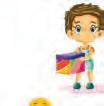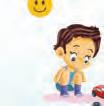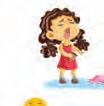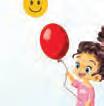
















































Learning goals













• Find similarities and differences
• Express their favorite activities, games, and sports







Main language content
Same, different

Circle time
Materials and preparation
• Calendar
• Puppet
• Visual schedule pictures
Say hello to students and have them say hello to you and the puppet. Have all the students sit in a circle, facing you. Review the procedures for gathering in a circle. Teach them an attention-getter. Say, Holy mole and have students respond, Guacamole .
Show students the calendar and ask them if they know the day and date today. Help them say the day and the number for the date.
Then show students the visual schedule pictures. Ask different students to help you find the ones that represent what you are doing in class today.
Materials and preparation
• Student’s Book


Outdoor activities, games, and sports

Lead students to their desks and ask them to open their Student’s Book to page 12. You might ask, What do you see? Do the people in the picture look the same or different?
Give them time to think and call out a few volunteers to answer your questions.
Then ask students to look around the classroom and check how different they are. You might say, Your hair is different, your skin color is different, etc.
Story time
Materials and preparation
• Big Book Unit 2: We love gym!
• Story time accessory
Put on a scarf, wig, or apron and tell students that every time they see you wearing it, it means you are going to read a story. Ask students where they want to sit for this activity and create a routine for it. They will know that every time they sit in that specific place and you are wearing the scarf, wig, or apron it is time for reading. You can say that if you tell them, Reading time, they should go to the place chosen. After some time, students will know where to go by only looking at your accessory. You might say, It is reading time and I need all eyes on me in one, two, three.
Story time
Materials and preparation
• Big Book Unit 2: We love gym!
Explore the first page of the story and draw students’ attention to the pictures and the title. You might ask them, What do you see? What do you think this story is going to be about?
Read the story and show the pictures according to the page you are reading. Ask students if they think their predictions were right. You might say, Was the story about what you thought or was it different?
Ask them to show you a thumbs-up or -down to check their answers.
Note to teachers
Make sure to have the book pictures visible for all the students when telling them stories.
work
Materials and preparation
• Cardboard for the posters
• Pictures of activities/games/sports from magazines: cut them out in advance
Form groups of four to five students. Ask them to make a poster with their three favorite outdoor activities, games, or sports. Ask students to raise their hands to indicate their favorite sports, games, or other outdoor activities. List and count what they like. Write the numbers. Point out that we all like different activities and we are all good at different things.
BELOW LEVEL
Ask probing questions.
Materials and preparation
• Big Book Unit 2: We love gym!
Look at the pictures together and have students talk about what they understood from the story. Ask probing questions to lead their thinking.
Note to teachers
Probing questions are questions that make students reflect, and not only give yes/no answers.
ABOVE LEVEL
Create a story.
Materials and preparation
• Big Book Unit 2: We love gym!
Ask students to come up with a new story using the same pictures.
Favorite activity
Materials and preparation
• Puppet
As a closing activity, ask students to think of their favorite outdoor activity and tell the class. You might say, As your exit slip, tell me what you like to do outdoors. After each student has talked about their favorite outdoor activity, say goodbye to them and encourage them to say goodbye to you and the puppet.
Note to teachers
This opportunity might be used as a formative assessment strategy. Make sure to take notes when assessing students’ progress.
SampleMaterial©Pearson2023

LOOK. WHAT ARE THE CHILDREN EATING? CIRCLE.










Circle time
Materials and preparation
• Calendar
• Puppet
• Visual schedule pictures






Learning goals
• Listen to, understand, and retell a story
• Identify and understand new words with the same initial sound
Main language content
Commands: sit down, stand up
Food item: popcorn
What are they eating?

Say hello to students and have them say hello to you. Have all the students sit in a circle, facing you. Review the procedures for gathering in a circle. Model where you will sit and where they will.
You might say, When I ask you to come to the circle, I expect you to walk quietly, sit down, and wait for everyone else to be seated. Model the signal you will use to call them back to you whenever they start talking:
T: Holy mole...
S: Guacamole!
As soon as they respond to it, they should be quiet and looking at you.
Note to teachers
You can always vary attention-getters in your classroom:
T: All set?
S: You bet!
T: Macaroniandcheese...
S: Let’s all freeze; etc.
Have the puppet move around the classroom, greeting each student and getting an answer from them in return.
Show students the calendar and ask them if they know the day and date today. Help them say the day and the number for the date. Then show students the visual schedule pictures. Call on a class helper of the day to help you find the ones that represent what you are doing in class today.
Look. What are the children eating? Circle.
Materials and preparation
• Flashcard: popcorn
• Pencils
• Student’s Book
Lead students to their desks. Hold up the flashcard. Students repeat the word popcorn. Hold up your book and point to the boy. You might say, His name’s Peter. Have students repeat, Peter. Point to the picture of the girl. Say, Hername’sPoppy Have students repeat, Poppy. Say, Stand up, indicating with your hands that you want students to stand up. Say, Sitdown, indicating with your hands that you want students to sit down.
Start telling the story your own way. As you tell it, make sure students understand you. Point to the picture of the girl and the boy when you are telling the story to give students a chance to explain what is happening.
Encourage them to tell the story using their own words. Guide them as they come up with their ideas. Have students open their Student’s Book to page 13 and draw their attention to the second picture. Ask, What are the children eating? Have them circle the popcorn.
Note to teachers
Use your imagination to tell the story about the pictures.
Brainstorming
Materials and preparation
• Flip chart
Ask students if they know other words starting with the sound /p/. Brainstorm ideas and write them on a flip chart.
Note to teachers
Make sure to add drawings that will serve as visual cues to each idea.
Drawing words with /p/
Materials and preparation
• Crayons
• Sheets of paper
Give students a sheet of paper and ask them to draw as many things as they can with the initial sound /p/.
BELOW LEVEL Retelling
Materials and preparation
• Student’s Book
In pairs, get students to retell each other the story while looking at the pictures. Remind those students who are listening to the story to pay attention to their classmate and help them as needed.
ABOVE LEVEL
Retelling
Materials and preparation
• Student’s Book
Have students retell the story in groups while adding a description to the pictures and using as many words as they can. Remind them to pay attention to the story.
Stand up!
Materials and preparation
• Puppet
Say, Stand up! and have students stand up. Then say, Sit down! and they all should sit down. Add more commands to the list and make sure to practice more than once.
Finally say goodbye to students and have them say goodbye to you and the puppet.

Circle time


Learning goals
• Reproduce and distinguish the initial consonant sound /p/
• Use the initial /p/ to make connections to other words

Main language content
Words beginning with P: panda
Commands: crisscross, cross
Animals: cat, dog
The panda is complete! Look! This is my panda mask!


Materials and preparation
• Calendar
• Puppet
• Visual schedule pictures
Say hello to students and encourage them to say hello or hi to you and the puppet. Gather students in a circle and review the procedures for sitting in a circle, walking safely, and not running in the classroom.
Review an attention-getter with your students. Say, Crisscross, apple sauce, pepperoni pizza. Have them repeat after you as you say the words, emphasizing the sounds /c/ and /p/.
Note to teachers
You might want to add gestures to the attention-getter, such as crossing their hands on their laps.
Show students the calendar and ask them if they know the day and date today. Help them say the day and the number for the date. Then place the visual schedule pictures face down in the middle of the circle. Say one of the stages of today’s class and call on students to turn over the pictures trying to find the one that represents that stage. Repeat until all correct pictures have been turned over.
Complete the panda.
Materials and preparation
• Pencils
• Student’s Book
Lead students to their desks and tell them to open their Student’s Book to page 14. Draw their attention to the panda. Ask them, Is the panda complete? What is missing? Tell students that the panda needs their help to be completed. Have them complete the missing parts of the panda. When they have finished, have them say, The panda is complete!
Panda mask
Materials and preparation
• Cardboard
• Hole punch
• Paper plates
Give students paper plates. Help them make two holes in the paper plates to make the eyes of the panda. Ask them to make ears and a nose with the cardboard. When they have finished, have them hold their masks up and walk around the classroom showing their panda masks to their classmates. and saying, Look! This is my panda mask!
BELOW LEVEL Draw animals.
Materials and preparation
• Crayons
• Sheets of paper
Elicit from students the animals they have studied so far. Give them sheets of paper and ask them to draw as many animals as they can.
ABOVE LEVEL
Say it and draw.
Materials and preparation
• Crayons
• Sheets of paper
In pairs, ask students to say an animal while the other draws. Then they take turns.
Imitate the animal and say goodbye.
Materials and preparation
• Puppet
Ask students to imitate animals in pairs. One student imitates and the other has to guess which animal that is. Make sure they take turns. Then tell students to imitate different animals as they say goodbye to you and the puppet. Imitate an animal yourself when responding.
Note to teachers
Make sure to model new activities first. You can call on a volunteer to help.

Circle time

Learning goals
• Say different colors
• Create, distinguish, and expand patterns
Main language content
What is the pattern?
What color is it?




Materials and preparation
• Calendar
• Pattern blocks
• Puppet
• Visual schedule pictures
Greet students as they come in. Shake their hand and say hello. Then ask how they are. For example:
T: Good morning, Paula!
S: Good morning, Miss Johnson!
T: How are you today?
S: I’m happy! Thank you!

Hi! Good (morning/afternoon)!
How are you, today?
Blue eye, brown eye, green eye
Colors: blue, brown, green
Shapes: circle, hexagon, square, triangle

Note to teachers
Make sure everyone is greeted by their names.
Use the puppet to greet students. Then have the puppet say, Say hello to your teacher! and encourage students to say hello to you. Have students sit in a circle. Take some pattern blocks and start a simple triangle or a hexagon pattern. Have some students come up and extend the pattern. Point to the shapes as the students clap and tap knees while saying, Triangle, hexagon, triangle, hexagon. Change the pattern with different shapes and/or actions: square, circle, square, circle, etc. Again, have students extend it and then you can clap and tap as you all chant.
Note to teachers
If you don’t have pattern blocks in your classroom, use cardboard to make the patterns beforehand.
Show students the calendar and ask them if they know the day and date today.
Help them say the day and the number for the date.
Then show students the visual schedule pictures. Call on a class helper of the day to help you find the ones that represent what you are doing in class today. Check with the rest of the class if this helper has selected the correct pictures.
Look and extend the pattern.
Materials and preparation
• Crayons
• Student’s Book
Ask students to sit in front of the board. Draw some eyes and color them blue, brown, blue. Ask what comes next. Model how to do the activity and ask them to open their Student’s Book to page 15. Practice several times, but do not draw the answers on the board. Erase the eyes on the board and then walk around and help students complete the page on their own. They should help each other, too. As they work, encourage them to point to the eye colors and say, Brown eye, blue eye, etc.
Rote count.
Materials and preparation
• Flashcards: numbers 1-10
Have students sit on the floor by a number line. Rote count to ten and back, pointing to the numbers. Repeat the procedure, clapping or tapping knees. Then point to a number and ask a student to walk around the classroom and bring that number of objects to you.
Note to teachers
You can also hand out number cards and ask each student to match them with the number line.
BELOW LEVEL
Continue the pattern.
Materials and preparation
• Pattern blocks
Give students a pattern of colors such as blue-green-blue. Ask them to continue the pattern.
ABOVE LEVEL
Real-life pattern
Have students create a real-life pattern with their eyes. If there is not a wide variety of eye colors in the classroom, they can create a big/small eye pattern or a hair color pattern.
Materials and preparation
• Blue, brown, and green shapes (different sizes)
• Crayons
• Pattern blocks
• Sheets of thick paper
Divide students into three groups. If you have a large class, divide students into six groups. Assign each group one of the following tasks:
• Group 1: Distribute the shapes and ask students to organize different shapes according to color or size.
• Group 2: Give students sheets of thick paper and crayons and tell them to draw different shapes on them. Then tell students to give their work to another classmate in the group. This classmate will say what shapes they can see.
• Group 3: Give students pattern blocks and ask them to build other possible shapes.
Monitor the activities and help students as needed.
Talk about the color and say goodbye.
Materials and preparation
• Cards in different colors
• Puppet
Ask students to stand up. Show each student some cards in different colors and ask, What color is this? Take notes of their answers and use them as a formative assessment. Then say goodbye to each of them and have them say goodbye to you and the puppet.

LOOK AT THE PICTURES.
CIRCLE OR .





Learning goals
• Identify happy and sad faces
• Identify and name boys and girls



Circle time





Main language content
Is he/she happy or sad? Who is happy?
Is it a boy or a girl?
Feelings: happy, sad
Materials and preparation
• Audio library – songs
• Calendar
• Puppet
• Visual schedule pictures
Greet students and have them greet each other. Then have the puppet greet them.
Play the It’s time to start our day song once or twice (track 03). Sing along and encourage students to join in.
Then go through the calendar routine, asking students about the day today and the date.
Select the visual schedule pictures you will need and place them out of order on the board. Then say each class activity in the order it will happen and ask students to point to it. Put the pictures in order as they point to the corresponding pictures.
Play the Happy and sad game.
Materials and preparation
• Happy basket and sad basket (two wastebaskets with paper labeling them, one with a sad face and one with a happy face)
• Two soft balls
Divide the class into two groups. One group will be the Happy group and the other, the Sad group. Line them up in two lines, one behind the other and tell them which group they belong to. Have them make a happy or sad face as you say the name of their group.
Explain that the Happy group has to throw a ball and get it into the happy basket and the Sad group has to get it into the sad basket. Every time one group scores a point, record the score on the board. When all the students have participated, see which group scored the most points. Then change groups and do the activity over again.
Look at the pictures. Circle happy or sad.
Materials and preparation
• Pencils
• Student’s Book
Lead students to their desks and help them open their Student’s Book to page 16. Draw a happy face and a sad face on the board. Hold your book up and point to the first picture. Ask, Is he happy or sad? When the students say happy, circle the happy face on the board. Tell them to do the same with the pictures in their Student’s Book. Monitor and help as needed.
BELOW LEVEL
Happy and sad
Materials and preparation
• Student’s Book
Prompt students to describe the pictures by asking, Who is sad? Have them point to the right girl and say, This girl. Then have them work in pairs. They will randomly point to the pictures and their classmate will say happy or sad
ABOVE LEVEL
This boy is happy!
Materials and preparation
• Student’s Book
In groups, have students go over the pictures and describe the feelings of the pictures they find using the vocabulary they know, for example: This boy is happy!
Materials and preparation
• Crayons
• Sheets of paper
• Small cards with happy and sad emoticons, at least eight of each
Divide students into three groups. If you have a large class, divide students into six groups. Assign each group one of the following tasks:
• Group 1: Give students the cards and have them create a pattern.
Examples:
Happy, sad, sad, happy, sad, sad,... Sad, happy, sad, happy,...
• Group 2: Give each student a sheet of paper. Ask them, Are you happy or sad? Have them draw a face showing how they feel.
• Group 3: Have a student in the group mime being happy or sad and tell the other students in the group to guess it. Have students take turns miming.
Monitor and help students as needed. If you have time, you can have students change stations after a while.
Sing If you are happy and you know it and say goodbye.
Materials and preparation
• Audio library – songs
Sing or play the If you are happy and you know it song (track 07). Make the movements while singing it and encourage students to join in.
Then have students say bye or goodbye to each other. Say goodbye to them, too.
Note to teachers
If students have a hard time remembering the lyrics for a long song, choose just one stanza and repeat it a few times. Then add stanzas as you feel they are ready.

TELL A CLASSMATE THE STORY.
Learning goals
• Understand a story
• Find similarities and differences
• Identify parts of the head and body


Circle time
Materials and preparation
• Calendar
• Puppet
• Visual schedule pictures
Main language content
Touch your arm.
Hop like a rabbit. Walk like a turtle. I have two (feet).
I don’t have four (feet).
Is (Big Ears) happy or sad?
Animals: rabbit, turtle

Greet students and have the puppet greet them, too. Shake their hand and say hello. Then ask how they are. For example:
T: Good (morning, Paula)!
S: Good (morning, Miss Johnson)!
T: How are you today?
S: I’m happy! Thank you!
Do the calendar routine with your students, looking at the day today and the date.
Then show them the visual schedule pictures. Call on a volunteer to be the class helper of the day and help you select the pictures that represent the activities as you say them.
Play Simon says.


Play Simonsays. Have Simon ask them to touch different parts of their bodies or head. Say, for example, (Simon says), touch your feet. Remind them that if you don’t say, Simon says, they should not touch any part of their body.
Listen. Circle why the rabbit loses.
Materials and preparation
• Audio library – class content
• Crayons
• Flashcards: rabbit, turtle
• Student’s Book
Lead students to their desks, show them the flashcards, and say what animals are shown there. Have students repeat the words rabbit and turtle. Then help them open their Student’s Book to page 17. Point to the rabbit and ask, What animal is this? (Is this a rabbit or a turtle?) Do the same with the turtle. After that point to the rabbit again and say, The rabbit’s name is Big Ears. Mime having big ears. Point to the rabbit’s ears and say, big ears Have students repeat. Then point to the turtle and say, The turtle’s name is Four Feet. Count the turtle’s feet aloud and have students count them, too. Say, Four Feet and have students repeat it after you.
Count your feet, One, two feet. Say, I have two feet, I do not have four feet. Ask students, Do you have two or four feet? Refer back to their Student’s Book and ask, Point to Big Ears/Four Feet.
After that, get students to tell the story the best they can, describing the pictures. Help them as needed.
Play the audio (track 04). Have students listen to it and follow it in their Student’s Book.
After they listen to the story, ask them, Is Four Feet happy or sad? Why? How about Big Ears, is Big Ears happy or sad? Why?
Have students praise Four Feet. Say, Good job, Four Feet! in a very enthusiastic way. Have students repeat it.
Finally tell students to circle the reason why the rabbit loses. Make sure students circle the picture that shows the rabbit sleeping.
This is Big Ears, the rabbit. This is Four Feet, the turtle.
One, two, three, Go! Goodbye, Big Ears!
Oh! Hello, Big Ears! Go! Go! Go! Four Feet!
Good job, Four Feet! Four Feet is very happy! But Big Ears is sad!
Note to teachers
When asking questions to students, ask them Wh-questions first. If students have a hard time giving the answers, ask Yes/No questions or questions which give them alternatives to choose from, such as Is this a rabbit or a turtle?
Think! question
Materials and preparation
• Student’s Book
Ask students the Think! question, Why does the turtle win the race? Have students discuss the reason, allowing everyone to participate.
Tell a classmate the story.
Materials and preparation
• Student’s Book
Encourage students to tell the story again as a class, following the pictures as you point to them. Monitor and help as needed.
Act out the story.
Bring two students out to the front to act like Big Ears and Four Feet and ask the rest of the students to tell the story as the pair act it out. Bring several more pairs to the front to be Big Ears and Four Feet and repeat the procedure.
BELOW LEVEL
What part of the body is it?
Materials and preparation
• Copies of the flashcards: rabbit, turtle
In small groups, students identify and describe the parts of the body of the rabbit and the turtle. Have them count all the eyes, ears, and feet they find.
ABOVE LEVEL
How are they different?
Materials and preparation
• Copies of the flashcards: rabbit, turtle
In small groups, students identify the differences between the rabbit and the turtle and themselves, for example: Two feet, four feet!
Play Big EarsandFour Feet and sing the Goodbyesong.
Materials and preparation
• Audio library – songs
• Chalk or tape
Remind students that Big Ears is a rabbit and that Four Feet is a turtle. Line students up and draw a finish line away from them using chalk or tape. Set up expectations of walking safely so as to avoid accidents. Give them commands such as, Hop like a rabbit. Freeze. Now walk like a turtle. If students can be taken outside, have them participate in an animal race. They can pretend to be animals that have four feet. Then wave goodbye to the students while singing the Goodbyesong
Note to teachers
Have students join in songs spontaneously. Do not insist that they do so, but encourage them and make them feel included in the activity.





Circle time



Materials and preparation
• Calendar
• Puppet
• Visual schedule pictures



Learning goals
• Recognize the initial sound /p/
• Recognize the letter P
• Identify and name parts of the body and head
• Find similarities and differences.
Main language content
Colors: pink, purple
Sizes: big, little
Parts of the body: feet, legs
Parts of the body: ears, eyes, mouth
Words beginning with P: panda, popcorn, puppet

Say hello to students and have them greet you and the puppet. Review the procedures for gathering in a circle and ask them if they can remember the attention-getter Macaroni and cheese… They should say, Let’s all freeze.
Do the calendar routine with your students, asking about the day today and the date.
Then show them the visual schedule pictures. Call on a volunteer to be the class helper of the day and help you select the pictures that represent the activities as you say them.
Panda or popcorn?
Materials and preparation
• Flashcards: foot, leg, panda, popcorn, rabbit
• Puppet
Place the flashcards for panda and popcorn up front as well as the puppet. Ask students to say the words. Then draw their attention to the P in each word, panda, popcorn, and puppet. Write the letter P on the board and say its sound a couple of times. Have students repeat.
Then hold up the flashcard for leg and say this word. Ask them, Does “leg” begin with /p/? Listen to their answers. Do the same with the flashcards and words foot and rabbit. Reinforce to the students that these sounds (/l/, /f/, and /r/) are different from the sound /p/. But do not expect them to produce these sounds perfectly well just yet.
Color the big pandas pink and the little pandas purple.
Materials and preparation
• Crayons: pink and purple
• Student’s Book
Lead students to their desks and help them open their Student’s Book to page 18. Draw students’ attention to the Ps. Ask them if the Ps are similar or different. After they realize the Ps are different, ask them how many big Ps there are. Encourage them to say, There are three big Ps. Do the same with the little Ps. After this show them a pink and a purple crayon and elicit the names of the colors, emphasizing the initial /p/ sound. Ask them to identify the big Ps and to color them pink. Then ask them to identify the little Ps and to color them purple. Monitor and help as needed.
Complete the drawing.
Draw a big circle on the board within students’ reach to make a panda’s body. Then draw a smaller circle on the top of the big circle, to make the panda’s head. Inside the head, draw two small circles with two even smaller circles in it to make the panda’s eyes. Point to your drawing and say, This is a panda. Point to the largest circle and say, This is the panda’s body. Point to the second largest circle and say, This is the panda’s head. Then ask, Where are the panda’s legs, feet, ears, and mouth? Say, We need to draw them. Have different students come to the board to draw the panda’s body and head parts. When the panda is complete, point to its parts and ask, What is this? or What are these? and have students name these parts.
Note to teachers
If the group of students is large, draw two or three pandas on the board and organize students into two or three groups.
BELOW LEVEL
Big and small: stand up and crouch down.
Tell students that when you say big they will have to stand up and stretch themselves up as much as they can and when you say small they will crouch down and become as small as possible. Give them these commands a few times, first alternate them and then repeat the same word a couple of times before alternating. Invite some students to give the commands after you demonstrate.
Note to teachers
Be sure not to only explain games in English, but to also demonstrate them.
Give students commands such as Touch your nose, touch your leg. Then encourage a few students to give the commands to the group themselves.
Sing Head, shoulders, knees, and toes and say goodbye.
Materials and preparation • Puppet
Sing the Head, shoulders, knees, and toes song. Make the movements while singing it and encourage students to join in. Then have students say bye or goodbye to each other. Say goodbye to them and have the puppet say goodbye, too.






Learning goals
• Identify and name parts of the body
• Understand and distinguish different parts of the body





Circle time
Materials and preparation
• Calendar
• Puppet
• Visual schedule pictures
Greet students and encourage them to greet you and the puppet. Gather students in a circle and review the procedures for sitting in a circle, walking safely, and not running in the classroom. Review one of the attention-getters. You might say, If I say, All set?, you will all answer, You bet! As soon as you say that, students are expected to be quiet and looking at you.
Note to teachers
You can also ask students to choose their favorite attention-getter so far.

Main language content
Parts of the body: arms, feet, fingers, foot, hands, head, legs, toes
Show students the calendar and ask them if they know the day and date today. Help them say the day and the number for the date. Then show students the visual schedule pictures. Call on a class helper of the day to help you find the ones that represent what you are doing in class today. Check with the rest of the class if this helper has selected the correct pictures.
Parts of the body
Materials and preparation
• Flashcards: arm, foot, hand, head, leg
Lead students to their desks and show them flashcards with different parts of the body. Call the words out ( arm , foot, hand, head, and leg ) and have them repeat after you.
Help students open their Student’s Book to page 19. Hold up your book and point to the picture of the hand. Say, This is a hand. Have students hold up one of their hands and say hand several times. Repeat the procedure with arm, leg, head, and foot
Complete the person. Listen. Do the actions.
Materials and preparation
• Audio library – class content
• Pencils
• Student’s Book
Say the words for the parts of the body out of order. Students point to the correct pictures and repeat them.
Help students learn the Parts of the body song (track 05) and do the actions. Draw their attention to the plural form of foot, which is feet. You do not have to explain this in details, but students should understand that they cannot add -s to the end of the word as they do in other words. Draw a body which resembles the one on the page on the board. Elicit where the
different body parts go and have students point to the corresponding places. Model how to connect the different parts to the main body. Monitor and help as needed. Check answers with the whole class.
Hands, hands, Clap, clap, clap.
Head, head, Tap, tap, tap. Arms, arms, Wave, wave, wave. Legs, legs, Bend, bend, bend. Feet, feet, Stomp, stomp, stomp.
Note to teachers
When teaching parts of the body, make sure to point to your own body. Students need visual cues, especially at this age.
Circle the fingers and toes.
Materials and preparation
• Pencils
• Student’s Book
Point to your body parts and teach the words fingers and toes. Have students circle them in the picture.
Sing Heads, ears, hair.
Materials and preparation
• Audio library – songs
Teach students the Head, ears, hair song (track 06) and point to the appropriate places on your body. Students join in, first pointing to the different parts of their body, and then singing along.
BELOW LEVEL
Group work
Materials and preparation
• Student’s Book
Organize students into groups of four and point to the Think! question. Have them count the number of arms and legs each of them has and report to the class.
ABOVE LEVEL
Pair work
Materials and preparation
• Student’s Book
Organize students into pairs and point to the Think! question. Have them count the number of arms and legs they have. Then have them also count the number of heads, hands, and fingers they have and report to the class.
Stick figures and say goodbye.
Materials and preparation
• Craft sticks or popsicle sticks
• Crayons
• Puppet
Give each student two craft sticks. Have them stick them together to make a figure (the arms are formed by sticking the sticks in like a cross). Have students draw a face at the top and hands and feet at the end of the sticks. Walk around as students describe their figures.
Then say goodbye to students and tell them to say goodbye to you and the puppet. Tell them to use their stick figure to say goodbye.
